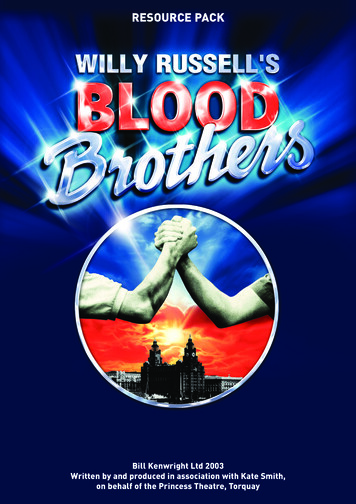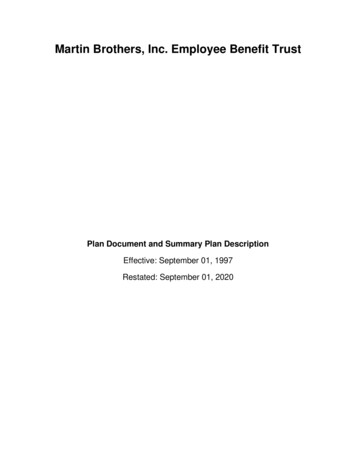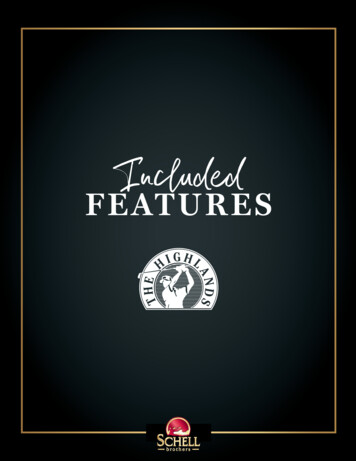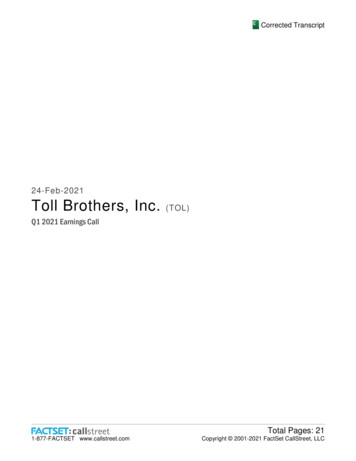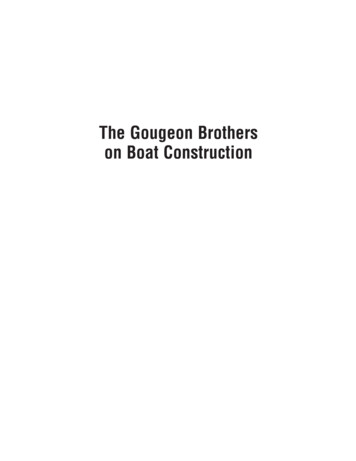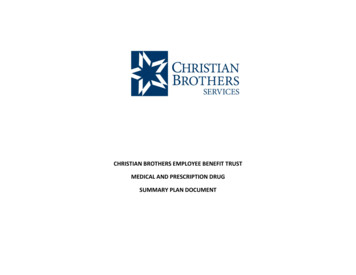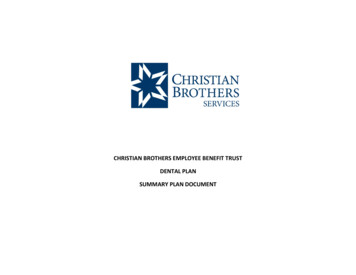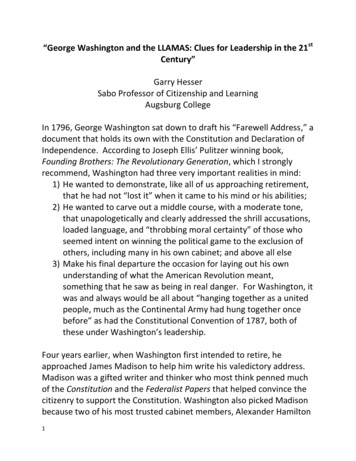
Transcription
“George Washington and the LLAMAS: Clues for Leadership in the 21stCentury”Garry HesserSabo Professor of Citizenship and LearningAugsburg CollegeIn 1796, George Washington sat down to draft his “Farewell Address,” adocument that holds its own with the Constitution and Declaration ofIndependence. According to Joseph Ellis’ Pulitzer winning book,Founding Brothers: The Revolutionary Generation, which I stronglyrecommend, Washington had three very important realities in mind:1) He wanted to demonstrate, like all of us approaching retirement,that he had not “lost it” when it came to his mind or his abilities;2) He wanted to carve out a middle course, with a moderate tone,that unapologetically and clearly addressed the shrill accusations,loaded language, and “throbbing moral certainty” of those whoseemed intent on winning the political game to the exclusion ofothers, including many in his own cabinet; and above all else3) Make his final departure the occasion for laying out his ownunderstanding of what the American Revolution meant,something that he saw as being in real danger. For Washington, itwas and always would be all about “hanging together as a unitedpeople, much as the Continental Army had hung together oncebefore” as had the Constitutional Convention of 1787, both ofthese under Washington’s leadership.Four years earlier, when Washington first intended to retire, heapproached James Madison to help him write his valedictory address.Madison was a gifted writer and thinker who most think penned muchof the Constitution and the Federalist Papers that helped convince thecitizenry to support the Constitution. Washington also picked Madisonbecause two of his most trusted cabinet members, Alexander Hamilton1
and Thomas Jefferson, were right in the middle of the acrimony anddisputes that Washington wanted to condemn.But the major point I want to make, which frames my reflectionstonight, grows out of the age old debate regarding just who furnishedthe words and was the “real and true author.” The “object of the huntsits right in front our eyes,” as Ellis puts it. Namely, “the creation of theFarewell Address was an inherently collaborative process. Some of thewords were Madison’s, some Hamilton’s; all were the ideas ofWashington that grew out of a lifetime of conversations andcollaborations with these two writers and colleagues. Madison wrotethe first draft from extensive notes taken in three conversations withWashington about the speech. Then Hamilton, four years later, wasgiven the draft and wrote most of the final version, with GeorgeWashington editing and revising extensively Hamilton’s final draft,wordsmithing and making 174 line changes out of 1086 in the text justbefore its publication.Ellis contends that the Farewell Address is a metaphor, and so do I, forthe kind of “collective effort [and leadership that] Washington wasurging on [his successors and] the American people as a whole.”Hamilton had experienced this style of leadership as a staff member toWashington in the Continental Army and in the cabinet.According to Ellis, for Washington, all major decisions were collective,in which each advisor, like spokes on a wheel, spelled out theirperspective, often in writing. But in the end, the final decision cametogether in the center which was Washington.So, just what were the central themes so important to Washington thatI also hold up before you, along with the LLAMAS: 1) the criticalimportance of “subordinating sectional and ideological differences tolarger national purposes;” 2) not being encumbered or having your2
hands tied by external alliances that would prevent the new nationfrom the flexibility to do what it needed to do; and 3) something thatHamilton left out.Hamilton convinced Washington to put it in his last State of the Unionaddress instead. Washington proposed a National University, in thenew capital. This was perhaps Washington’s greatest dream—a placeand space where young citizens from every state and region wouldcome together, “and by degrees discover that there was not just causefor those jealousies and prejudices which one part of the Union hadimbibed against another part.” Washington had seen the oppositehappen, especially in his close-up experience with young soldiers in theContinental Army, as well as the Constitutional Convention, where allthe soldiers and delegates from every region stuck together, with acommon purpose, until they had accomplished their objectives.Washington clearly wanted to pass on his legacy and his explanation ofwhat the American Revolution meant to him and what would berequired of citizens who, with all their differences could and “musthang together as a united people.”I will return to George Washington again at the conclusion. But I trustyou also see the implicit, if not explicit, qualities of collaboration andsystem thinking that played out in Washington’s leadership approach,ideas that have been fleshed out by “research on” and “practice of”leadership over the years since Washington. And most of theseelements are spelled out in the acronym: LLAMAS.We start with LISTEN, which is the first among equals.When Larry Spears of the Greenleaf Center created a list of the top 10qualities of a leader, the very first one was “Listening.” Not just passivelistening, but “on the edge of your seat,” and a leaning forward type ofhuman engagement.3
Those of you who have been in the “Creativity and Problem-Solving”class know that I have been deeply influenced by Myles Horton and theHighlander Center in Tennessee where “deep listening” is practicedalmost as a sacred ritual. Deep listening underscores, among otherthings, that we have two ears and one mouth, suggesting that weshould listen at least twice as much as we talk.Myles Horton and Highlander remind us that we all need help andtraining in order to create social settings where real listening andgrowth can take place.At Highlander, in order to address the tendencies of people like mewho “open our mouths and begin to talk in search of an idea,” we sit ina circle of rocking chairs, and engage in what we call deep listening.Each participant offers her or his response to a question which zeroesin on the reason we gathered, with each person’s articulation based ontheir own lived experiences and current understanding.The norm, and clear expectation, as we go around the circle, is that noone ever interrupts, responds, adds to, or questions the speaker who isgiven a reasonable amount of time negotiated initially by the group inlight of its size. The next “go around” question might likely be: “OK,what did you learn from the others that adds to your understanding ofthe issue/problem that has brought us together?” The Native American“talking stick,” World Café, and the Art of Hosting movement are otherexamples of socially constructing effective arrangements for socialinteraction that help us learn more effectively how to listen moredeeply to others.It would appear that George Washington, even as an aristocrat,General, and President intuitively knew and practiced his own version4
of “deep listening,” something I keep learning about in other effectiveleaders, including our current President.Listening is closely linked to LEARNINGPeter Senge, building on the wisdom of his mentors, Donald Schoenand Chris Argyris, all at MIT, also expands on the critical importance oflistening if leaders are to turn their work places into “learningorganizations.” At the center is a deep listening that results in whatPeter Senge likes to call “dialogue.” Dialogue is more likely to lead tolearning, according to Senge, than debate or even discussion, becausethose engaged in dialogue engage in listening assuming that theconversation will indeed transform their own thinking. So, instead ofseeking out conversation partners who will reinforce one’s ownperceptions, participants anticipate that their understanding will bechanged by a dialogical conversation with the others. Everyone in adialogue is asking the others for help in “seeing their own seeing,” asSenge puts it.Another aspect of “learning organizations” is a systems thinkingorientation, stressing connections to the whole, insisting that we lookbeyond the immediate context and appreciate the impact of ouractions upon others, such as seven generations from now as our NativeAmerican friends invite us to do. “Seeing from the whole” is howSenge and his colleagues put it.ASKING is closely linked to listening and learning from othersIf a leader is not genuinely “curious” and eager to learn what othersknow and see, I truly doubt that dialogue and growth will occur.At Highlander, one of the primary tasks of the leader-facilitator is toframe good questions that invite members of the group or team to“learn from their own experiences” and current understandings.5
Paul Tillich, one of the 20th Century’s greatest philosophers andtheologians, contended that good questions, grounded in humanexistence and reality, are usually far more valuable to our learning thanthe answers themselves.Or, as Elie Wiesel recalls about a mentor who helped him survive theHolocaust:“He explained to me with great insistence that every questionpossessed a power that did not lie in the answer.”― Elie Wiesel, NightPoetically, Rilke seems to say much that needs to be said about theimportance of asking and questioning:“Have patience with everything that remains unsolved in yourheart. Try to love the questions themselves, like locked rooms andlike books written in a foreign language . At present you need to[simply] live the question. Perhaps you will gradually, withouteven noticing it, find yourself experiencing the answer .”― Rainer Maria Rilke, Letters to a Young PoetIt is critical that leaders create the settings and cultures wherequestions and asking are welcome, safe and expected.Peter Senge and his colleagues propose that effective leaders, engagedin dialogue, put their own best thinking and assumptions out “on thetable.” Then, leaders ask, with utmost seriousness, that theircolleagues and staff “help them see their own seeing,” especially itsweaknesses and underlying assumptions. Leaders probe, as fullparticipants in the group, asking and being asked.It is just this kind of genuine collaboration and openness, paradoxicallydone with self-confidence and humility, that puts flesh on the first,6
second and third letters of Llama. Leadership, I am convinced, requiresthat leaders authentically engage in Listening, Learning and Asking.This is not “rocket science.” But as my friend, Ira Harkevy at Penn says,“It’s more complicated than rocket science.”I hope that you are now asking: “How does a leader, or anyone, movefrom Listening, Learning and Asking to action and exercising agency?MEDITATE, my friends, meditate.Something else is emerging in the literature and the practice ofleadership. Buddhists call it “mindfulness,” others “meditation” or“deep reflection,” or “prayer.” Much to their amazement, many, if notmost of the leaders interviewed for the book, Presence, engageregularly in some form of disciplined meditation or contemplation.Centering, mindfulness and “letting go of the need to control” becomeboth personal and collective practices that Peter Senge and hiscolleagues underscore for LLAMA leaders. Senge, who rarely talksabout it, walks his own talk and meditates one hour every day. Theimportance of “being present” in mindfulness is so central to their UTheory of leadership that the title of their book is Presence and hasgiven rise to a global movement, The Presencing Institute at MIT.Presencing is “given legs” locally by the Bush Foundation and known asInCommons. I have a handout on the U-Theory & Presencing availablefor any who would like to learn more.ACTION or ACTING actualize our AGENCY, which is a verb, not a nounAnthony Giddens, a prominent sociologist and advisor to the PrimeMinister of Great Britain, along with most sociologists, reminds us thathuman beings have the capacity for agency. Agency, we contend, is thegift of being able, as individuals and groups, to socially construct andreconstruct the realities in which we operate, with one huge caveat:7
Some people and groups have a lot more agency than others. Some aremore and others are less privileged—it’s not a level playing field. Andthat is where leadership comes into play.As Harry Boyte, our colleague at the Sabo Center for Citizenship andLearning stresses, we all, especially leaders, can and should attend tothe “development of efficacy [i.e., a sense of agency], not only inoneself, but in those most affected by a problem.”In leadership terms, that means that it is critical for leaders to fosterand cultivate a sense of agency in our colleagues so that they also cometo see themselves as having both the right and the capacity to have asay and influence in our common work, as Harry puts it. And it is“work,” but good work, as Harry also reminds us.The authors of Presence are quite specific regarding Agency and Action.In the context of ongoing Listening, Learning, Asking and Meditating,they emphasize Prototyping and Institutionalizing. LLAMA Leaders, Iam suggesting, engage in and encourage others to experiment, to “actand fail with a sense of purpose.” And this kind of courage andaudacity is usually based on listening, both to one’s inner voice and thetransformational learning that comes through dialogue and listening.Senge and his colleagues underscore why sociologists devote so muchof our attention to “institutions,” those enduring patterns,relationships, structures and networks that enable humans to addressthe timeless needs that all societies and communities experience. TheU-Theory, as you can see in the handout, posits a dynamicunderstanding of institutionalization and emphasizes “embodying ournew insights and realizing them through transforming action andinstitutions.”8
Exercising our agency, and embolding others to do the same, can saveus from continually reinventing the wheel because institutionalizing,without succumbing to rigid bureaucratizing or formulas, allows us toaddress what can make society and our organizations more humane,equitable and just. Prototyping and institutionalizing, when done in thespirit of Agency and Llama leadership embrace and embody atransformational process that is continually renewing and engaging in anever ending journey.And now, as I move toward an end to these comments, note thatLlamas is plural. As promised, we return to George Washington, with alittle help from Robert Greenleaf.When asked how one will know that one has been a Servant-Leader,Greenleaf put it this way:“Do those served grow as persons? Do they, while being served,become healthier, wiser, freer, more autonomous, more likelythemselves to become servants?”It is really all about SHARING and passing it on.Llama Leaders share who they are and what they know.George Washington’s dream was to pass on a legacy of “hangingtogether as a united people .subordinating sectional and ideologicaldifferences to larger national purposes” and mobilizing all ourdifferences in ways that indeed might make the new democracy abeacon on the hill worthy of emulating.And Washington was a good sociologist, even before the disciplineexisted. He knew that such a vision needed to be “institutionalized.”Washington envisioned a National College where, as noted earlier,young citizens from every state and region, from all walks of life, would9
come together just as he had experienced first-hand with the youngsoldiers in the Continental Army and the delegates to the ConstitutionalConvention. I find it interesting that the closest we have ever come tothis seems to be our Military Academies and the military overall. Theyare more integrated socially, racially and in sexual preference thanalmost any other institution in our society, thanks to two successors ofWashington, namely Harry Truman and Barack Obama.Yes, Washington espoused sharing and passing it forward through aNational University, an institution dedicated both to the growth of theindividuals who attended and committed to building democracy andstrong, resilient communities, marked by both diversity and unity.And this leads us to our final letter, a second “S” mirroring LLAMAwhich begins with two LLs.Dynamic institutionalizing requires SPACES:LLAMA leaders, like Washington, know that there is a need for safe andinviting spaces, environments where creativity, problem-solving andgrowth can happen.Steven Johnson, in Where Good Ideas Come From: The Natural Historyof Innovation, assessed hundreds, even 1000s, of inventions andproblem-solving. He concluded that the single most important variablewas space, environments for thinking and networking with others.Yes, you and I, as Llama leaders, can exercise human agency and, likeWashington, “create and maintain environments and spaces, where welisten and learn from each other, spaces and places for meditation andcontemplation, where transformation is more likely to happen.10
Highlander, the World Café, the Art of Hosting, Dialogical Conversations, and the Presencing Institute are five expressions of this new waveof “institutions” that are committed to equipping leaders who createsafe spaces where people can address the complex realities we face inour diverse, polarized and conflicted world.And I also want to name one reality that is often ignored or “brushedover” by Senge and Greenleaf--namely power. Llama leaders, I amconvinced, know it in their very being, or learn, that the symbols andreality of power and privilege are real. With this insight, they seek outor create spaces and places that significantly “level the playing field,”instead of gravitating to spaces that underscore their own power,privilege and authority. One simple example would be going tosomeone’s office to talk about an issue or problem instead of inviting,or summoning, them to yours. Similarly, it might mean convening onthe turf of those who work with you instead of a more opulentconference room in the executive suite. Being continually conscious ofpower and symbols of power makes a significant difference. LLAMAleaders know that “place and power matters.”I have had the good fortune to live with someone for the past fourdecades who understands and models this day in and day out for meand those with whom she works.My favorite new book, along with Founding Brothers, is entitled WhyDid Jesus, Moses, the Buddha, and Mohammed Cross the Road?I strongly agree with Brian McLaren, the author, that the answer to thatintriguing question looks a lot like a collection of Llama Leaders.McLaren and I both think these four would cross the road to find orcreate a new space, a neutral and safe place, where they could sharewith each other, learn from each other, meditate and be transformed11
themselves. As a result, each of them could and would be better ableto build up their next generation of followers in ways that would alsolead to harmony and dialogue as their followers interact with eachother and with those who follow the others in never ending growth andchange.Toward the end of the book, McLaren offers a quote by VincentDonovan, that I adapt to close: [p. 254]Leaders who are LLAMAS do not leave others where they have been.But neither do they try to bring those they lead to where they are atpresent, as beautiful as that place or way of doing things or thinkingmight be Rather, LLAMA LEADERS invite others to go with them to aplace where neither the leader or the followers have ever been before.May we all be so fortunate as to have this a reality in our own lives.12
Or, as Elie Wiesel recalls about a mentor who helped him survive the Holocaust: "He explained to me with great insistence that every question possessed a power that did not lie in the answer." ― Elie Wiesel, Night Poetically, Rilke seems to say much that needs to be said about the importance of asking and questioning:



